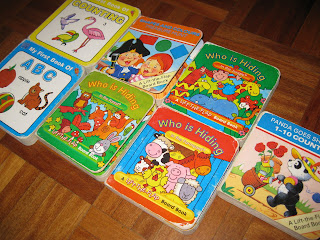These are our set of well-worn and well-loved books for infants, most of which were purchased a decade ago from The Reject Shop, one of those two dollar emporiums full of junky goods and occasional cheap treasure. They are pocket-sized editions made of hard cardboard. Some have lift the flap pages which provided endless hours of entertainment for our littlies. Great value for money.
Even though they were either written in the UK or the US and included images of non-indigenous animals, such as hedgehogs, squirrels, pandas, flamingoes and deer, which we were never, ever likely to see, the children happily accepted that these were real things. Should we have encountered elephants tromping down Commonwealth Avenue or cows or pirates on the way to the supermarket, my toddlers would have known them instantly and thought it perfectly natural.
I've always thought it odd that so many of our early books were about farm and zoo animals neither of which were part of our suburban life. I've noticed there are more picture books these days about life in cities which feature everyday items, but they are still mostly from overseas and there is the occasional need for a translation eg. from lollipop to iceblock.


Lovely memories, but what to do with the books now that we have outgrown them?
Stop being so sentimental for one and look forward to collecting those lovely thick chapter books. Now that we know our A,B,C. Sigh...




